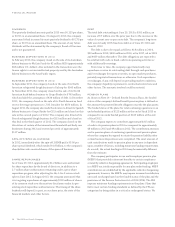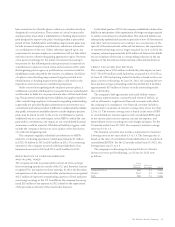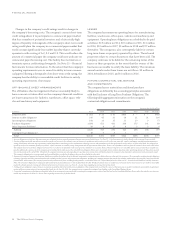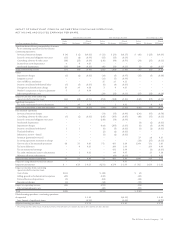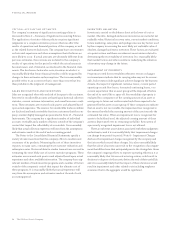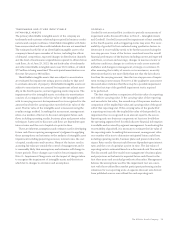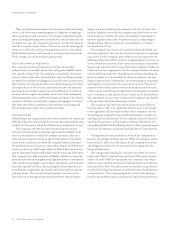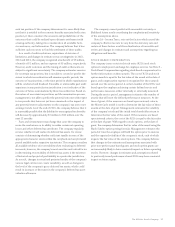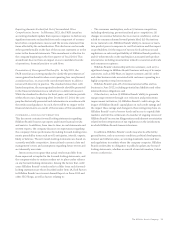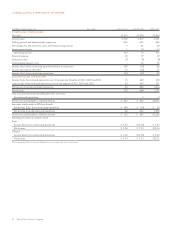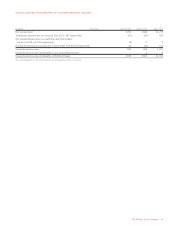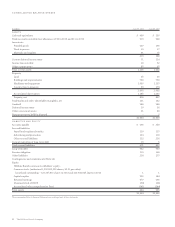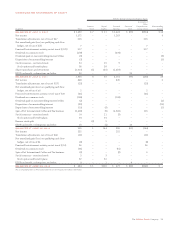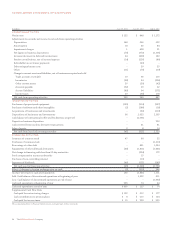Sara Lee 2013 Annual Report Download - page 27
Download and view the complete annual report
Please find page 27 of the 2013 Sara Lee annual report below. You can navigate through the pages in the report by either clicking on the pages listed below, or by using the keyword search tool below to find specific information within the annual report.The Hillshire Brands Company 25
TRADEMARKS AND OTHER IDENTIFIABLE
INTANGIBLE ASSETS
The primary identifiable intangible assets of the company are
trademarks and customer relationships acquired in business combi-
nations and computer software. Identifiable intangibles with finite
lives are amortized and those with indefinite lives are not amortized.
The estimated useful life of an identifiable intangible asset to the
company is based upon a number of factors, including the effects
of demand, competition, expected changes in distribution channels
and the level of maintenance expenditures required to obtain future
cash flows. As of June 29, 2013, the net book value of trademarks
and other identifiable intangible assets was $121 million, of which
$77 million is being amortized. The anticipated amortization over
the next five years is $40 million.
Identifiable intangible assets that are subject to amortization
are evaluated for impairment using a process similar to that used
to evaluate elements of property. Identifiable intangible assets not
subject to amortization are assessed for impairment at least annu-
ally, in the fourth quarter, and as triggering events may arise. The
impairment test for intangible assets not subject to amortization
consists of a comparison of the fair value of the intangible asset
with its carrying amount. An impairment loss is recognized for the
amount by which the carrying value exceeds the fair value of the
asset. The fair value of the intangible asset is measured using the
royalty savings method. In making this assessment, management
relies on a number of factors to discount anticipated future cash
flows including operating results, business plans and present value
techniques. Rates used to discount cash flows are dependent upon
interest rates and the cost of capital at a point in time.
There are inherent assumptions and estimates used in developing
future cash flows requiring management’s judgment in applying
these assumptions and estimates to the analysis of intangible asset
impairment including projecting revenues, interest rates, the cost
of capital, royalty rates and tax rates. Many of the factors used in
assessing fair value are outside the control of management and it
is reasonably likely that assumptions and estimates will change in
future periods. These changes can result in future impairments.
Note 4 – Impairment Charges sets out the impact of charges taken
to recognize the impairment of intangible assets and the factors
which led to changes in estimates and assumptions.
GOODWILL
Goodwill is not amortized but is subject to periodic assessments of
impairment and is discussed further in Note 3 – Intangible Assets
and Goodwill. Goodwill is assessed for impairment at least annually,
in the fourth quarter, and as triggering events may arise. The recov-
erability of goodwill is first evaluated using qualitative factors to
determine if recoverability needs to be further assessed using the
two-step process. Some of the factors considered were the overall
financial performance of the business including current and expected
cash flows, revenues and earnings; changes in macroeconomic or
industry conditions; changes in cost factors such as raw materials
and labor; and changes in management, strategy or customers. If,
after assessing the totality of events or circumstances, an entity
determines that it is not more likely than not that the fair value is
less than the carrying amount, then the two-step process of impair-
ment testing is unnecessary. However, if the qualitative assessment
discussed above indicates that there may be a possible impairment
then the first step of the goodwill impairment test is required
to be performed.
The first step involves a comparison of the fair value of a reporting
unit with its carrying value. If the carrying value of the reporting
unit exceeds its fair value, the second step of the process involves a
comparison of the implied fair value and carrying value of the good-
will of that reporting unit. If the carrying value of the goodwill of
a reporting unit exceeds the implied fair value of that goodwill, an
impairment loss is recognized in an amount equal to the excess.
Reporting units are business components at least one level below
the operating segment level for which discrete financial information
is available and reviewed by segment management. In evaluating the
recoverability of goodwill, it is necessary to estimate the fair value of
the reporting units. In making this assessment, management relies
on a number of factors to determine anticipated future cash flows
including operating results, business plans and present value tech-
niques. Rates used to discount cash flows are dependent upon interest
rates and the cost of capital at a point in time. The fair value of
reporting units is estimated based on a discounted cash flow model.
The discounted cash flow model uses management’s business plans
and projections as the basis for expected future cash flows for the
first three years and a residual growth rate thereafter. Management
believes the assumptions used for the impairment test are consis-
tent with those utilized by a market participant performing similar
valuations for our reporting units. A separate discount rate derived
from published sources was utilized for each reporting unit.





